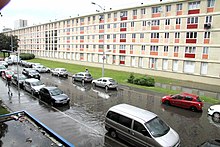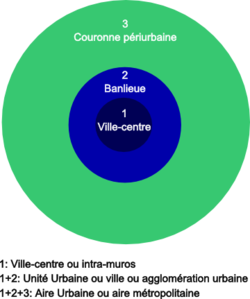

In France, a banlieue (UK: /bɒnˈljuː/; French: [bɑ̃ljø] ) is a suburb of a large city, or all its suburbs taken collectively. Banlieues are divided into autonomous administrative entities and do not constitute part of the city proper. For instance, 80 percent of the inhabitants of the Paris metropolitan area live outside the city of Paris.
Beginning in the 1970s, the term banlieue has taken on a particular connotation, becoming a popular word for economically-deprived suburbs featuring low-income housing projects (HLMs) that are home to large immigrant populations. People of foreign descent reside in what are often called poverty traps.
Etymology
The French word banlieue is derived from the thirteenth century Vulgar Latin term banleuca composed of the German term ban meaning decree or official announcement with leuca which refers to the extension of the authority beyond the walls of a town.
History

In France, since the establishment of the Third Republic at the beginning of the 1870s, communities beyond the city centre essentially stopped spreading their own boundaries, as a result of the extension of the larger Paris urban agglomeration. The city – which in France corresponds to the concept of the "urban unit" – does not necessarily have a correspondence with a single administrative location, and instead includes other communities that link themselves to the city centre and form the banlieues.
Since the annexation of the banlieues of major French cities during the Second Empire period (Lyon in 1852, Lille in 1858, Paris in 1860, Bordeaux in 1865), French cities have extended their boundaries very little despite the growth of the cities. Almost all large and mid-sized cities in France with a banlieue have developed a couronne périurbaine (in English: peri-urban ring).
Communities in the countryside beyond the near-urban ring are regarded as being outside the city's strongest social and economic sphere of influence, and are termed communes périurbaines. In either case, they are divided into numerous autonomous administrative entities.
Banlieues 89, a design-led urban policy backed by the French government, renovated over 140 low-cost estates, such as Les Minguettes and the Mas du Taureau block in Vaulx-en-Velin. Improvements were made in road and rail access, cafes and shops were built, and the towers and blocks were made to look more attractive. In Vaulx-en-Velin, for instance, shops and a library were built, houses were built to make the landscape more interesting, 2,500 homes were renovated, and the blocks were repainted.
Geography of the banlieues

The word banlieue is, in formal use, a socially neutral term, designating the urbanized zone located around the city centre, comprising both sparsely and heavily populated areas. Therefore, in the Parisian metropolitan area, for example, the wealthy suburb of Neuilly-sur-Seine may be referred to as a banlieue as might the poor suburb of La Courneuve. To distinguish them, Parisians refer to a banlieue aisée (in English: comfortable suburb) for Neuilly, and to a banlieue défavorisée (in English: disadvantaged suburb) for Clichy-sous-Bois.
Paris

The Paris region can be divided into several zones. In the northwest and the northeast, many areas are vestiges of former working-class and industrial zones, in the case of Seine-Saint-Denis and Val-d'Oise. In the west, the population is generally upper class, and the centre of business and finance, La Défense, is also located there. Versailles, Le Vésinet, Sceaux, Maisons-Laffitte and Neuilly-sur-Seine are affluent suburbs of Paris, while Clichy-sous-Bois, Bondy and Corbeil-Essonnes are less so.
The southeast banlieues are less homogenous. Close to Paris, there are many communities that are considered "sensitive" or unsafe (Bagneux, Malakoff, Massy, Cachan, Les Ulis), divided by residential zones with a better reputation (Verrières-le-Buisson, Bourg-la-Reine, Antony, Fontenay-aux-Roses, Sceaux).
The farther away from the Paris city centre, the more the banlieues of the south of Paris can be divided into two zones. On one side, there are the banks of the Seine, where working-class residents used to live (there are still pockets of disadvantaged areas) but also other areas that are especially well off. Also are large cities close to Paris, such as Chanteloup-les-Vignes, Sartrouville, Les Mureaux, Mantes-la-Jolie, Poissy, Achères, Limay, Trappes, Aubergenville, Évry-Courcouronnes, Grigny, Corbeil-Essonnes, Saint-Michel-sur-Orge, Brétigny-sur-Orge, Sainte-Geneviève-des-Bois and Fleury-Mérogis.
On the other hand, small communities that are affluent can be found in the Yvelines department with Villennes-sur-Seine, Chatou, Croissy-sur-Seine, Le Pecq, Maisons-Laffitte but also in the Essonne and Seine-et-Marne departments: Etiolles, Draveil, Soisy-sur-Seine, Saint-Pierre-du-Perray or Seine-Port.
Paris: Banlieues rouges
The banlieues rouges ("red banlieues") are the outskirt districts of Paris where, traditionally, the French Communist Party held mayorships and other elected positions. Examples of these include Ivry-sur-Seine and Malakoff. Such communities often named streets after Soviet personalities, such as Avenue Vladimir-Ilitch-Lénine in Nanterre, or rue Youri Gagarine in Colombes.
Lyon and Marseille
The banlieues of large cities like Lyon and Marseille, like those of Paris, have also tended to suffer from a negative reputation. Ever since the French Commune government of 1871, they were and still are often ostracised and considered by other residents as places that are "lawless" or "outside the Republic", as opposed to "deep France", or "authentic France" associated with the provinces. However, it is in the banlieues that the young working households are found that raise children and pay taxes but lack in public services, in transportation, education, sports, as well as employment opportunities.
Crime and protests
Main article: Social situation in the French suburbs| This article needs additional citations for verification. Please help improve this article by adding citations to reliable sources. Unsourced material may be challenged and removed. Find sources: "Banlieue" – news · newspapers · books · scholar · JSTOR (October 2021) (Learn how and when to remove this message) |
Since the 1980s, petty crime has increased in France, much of it blamed on juvenile delinquency fostered within the banlieues. As a result, the banlieues are perceived to have become unsafe places to live, and youths from the banlieues are perceived to be one important source of increased petty crimes and uncivil behaviour. This criminality was addressed by the Front National, a far-right political party led by Jean-Marie Le Pen, which rose to prominence during the early 1990s on a platform of tougher law enforcement and immigration control.
1981 riots
In the summer of 1981, events involving young Franco-Maghrebis were met with varying reactions from the French public. Within the banlieues, events, called rodeos, would occur, where young "banlieusards" would steal cars and perform stunts and race them. Then, before the police could catch them, they would abandon the cars and set them on fire.
In July and August 1981, around 250 cars were vandalised. Grassroots groups began to demonstrate in public in 1983 and 1984 to publicise the problems of the Beurs and immigrants in France.
2005 riots
Main article: 2005 Paris suburb riotsViolent clashes between hundreds of youths and French police in the Paris banlieue of Clichy-sous-Bois began on 27 October 2005 and continued for more than 17 nights. The 2005 Paris suburb riots were triggered by the deaths of two teenagers (of black and Maghrebi descent) allegedly attempting to hide from police in an electrical substation, who were electrocuted.
2020 riots
From 18 April 2020, Paris saw several nights of violent clashes over police treatment of ethnic minorities in the banlieues during the COVID-19 lockdown.
2023 riots
Main article: Nahel Merzouk riotsFilmography
A number of films, both fiction and documentary, have focused on the banlieues. A selection are listed below.
- L'amour existe, Maurice Pialat, 1961
- Two or Three Things I Know About Her, Jean-Luc Godard, 1967
- Elle court, elle court la banlieue, Gérard Pirès, 1973
- Série noire, Alain Corneau, 1979
- La Haine, Mathieu Kassovitz, 1995
- 100% Arabica, Mahmoud Zemmouri, 1997
- Ma 6-T va crack-er, Jean-François Richet, 1997
- Games of Love and Chance, Abdellatif Kechiche, 2004
- District 13, Pierre Morel, 2004
- La Journée de la jupe, Jean-Paul Lilienfeld, 2008
- Neuilly Yo Mama!, Gabriel Julien-Laferrière, 2008
- Tout ce qui brille, Géraldine Nakache, 2010
- Beur sur la ville, Djamel Bensalah, 2011
- Porn in the Hood, Franck Gastambide, 2012
- On the Other Side of the Tracks', Bertrand Tavernier, 2012
- Girlhood, Céline Sciamma, 2014
- Dheepan, Jacques Audiard, 2015
- Divines, Houda Benyamina, 2016
- Les Misérables, Ladj Ly, 2019
- Athena, Romain Gavras, 2022
- Infested, Sébastien Vaniček, 2023
See also
- Aire urbaine
- Bidonville
- Faubourg
- Poverty in France#Bidonvilles
- Social situation in the French suburbs
- Sensitive urban zone
References
- "banlieue". Lexico UK English Dictionary. Oxford University Press. Archived from the original on 30 November 2020.
- "Archived copy". Archived from the original on 29 October 2013. Retrieved 14 August 2013.
{{cite web}}: CS1 maint: archived copy as title (link) - Lepoutre, David (1997). Coeur de banlieue: codes, rites, et langages. Odile Jacob.
- Harper, Douglas. "banleuca". www.etymonline.com. Douglas Harper. Retrieved 1 October 2023.
- Modern Industrial World: France by Mick Dunford, Wayland Publishers Ltd, 1994
- Anne-Marie Thiesse (1997) Ils apprenaient la France, l'exaltation des régions dans le discours patriotique, MSH.
- La ville mal aimée, colloque de Cerisy-la-Salle, juin 2007.
- ^ Gross, Joan; McMurray, David; Swedenburg, Ted (1994). "Arab Noise and Ramadan Nights: Rai, Rap, and Franco-Maghrebi Identities". Diaspora. 3 (1): 3–39. doi:10.1353/dsp.1994.0010. S2CID 144031230. Reprinted in Gross, Joan; McMurray, David; Swedenburg, Ted (2002). "Arab Noise and Ramadan Nights: Rai, Rap, and Franco-Maghrebi Identities". In Inda, Jonathan Xavier; Rosaldo, Renato (eds.). The Anthropology of Globalization: A Reader. Oxford: Blackwell. pp. 198–230. ISBN 978-0-631-22233-0.
- BBC News Timeline: French Riots, 14 November 2005 – retrieved 14 March 2010 http://news.bbc.co.uk/2/hi/europe/4413964.stm
- Emilio Quadrelli, Grassroots Political Militants: Banlieusards and Politics, Mute Magazine, May 2007 "Mute magazine - Culture and politics after the net". Archived from the original on 11 October 2008. Retrieved 31 October 2008.
- "Police clash with residents in Paris suburbs amid lockdown". France 24. 20 April 2020.
- "Violence flares in tense Paris suburbs as heavy-handed lockdown stirs 'explosive cocktail'". France 24. 21 April 2020.
- "Unrest, hunger and hardship in France's locked-down suburbs". Euronews. 23 April 2020.
Further reading
- Bronner, Luc (2010): La loi du ghetto : Enquête sur les banlieues françaises, Calmann-Lévy, Paris, ISBN 978-2702140833
- Dikec, Mustafa (2007): Badlands of the Republic: Space, Politics and Urban Policy. ISBN 978-1-4051-5630-1
- Glasze, Georg; Robert Pütz, Mélina Germes et al. (2012): The Same but not the Same: the Discursive Constitution of Large Housing Estates in Germany, France and Poland. Urban Geography (33) 8: 1192–1211 doi:10.2747/0272-3638.33.8.1192
External links
- The New French Ghettos by Hervé Marchal & Jean-Marc Stébé, in Metropolitics.eu, 16 December 2010.
- The Barbarians at the Gates of Paris by Theodore Dalrymple in City Journal, Autumn 2002.
- The Other France – Are the suburbs of Paris incubators of terrorism? by George Packer in The New Yorker, 31 August 2015.
- So long, Marianne on burning girls and burning cars in France by Alice Schwarzer at signandsight.com
- The price of disdain French author François Bon has spent years giving writing workshops to youths in the suburbs that are now being set ablaze. He looks critically at where the violence originated and with despair at where it is headed, at signandsight.com
- French Riots Special A dossier with four related feature articles as well as a comprehensive collection of international voices from In Today's Feuilletons and the Magazine Roundup of sighandsight.com
- From Paris to Cairo: Resistance of the Unacculturated
- Website featuring underground rap music from the banlieues.
- Troubled Suburbs Erupt Again
- (in French) Audio book (mp3) of the introduction and first chapter of Éric Maurin's book : Le ghetto français, enquête sur le séparatisme social